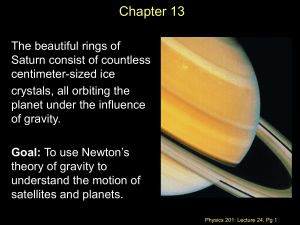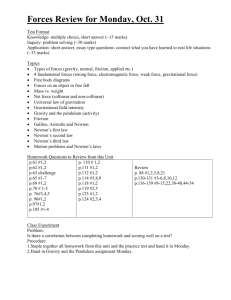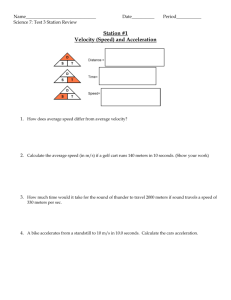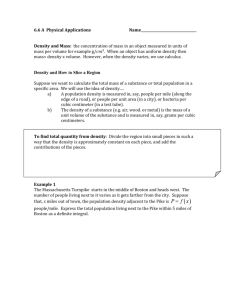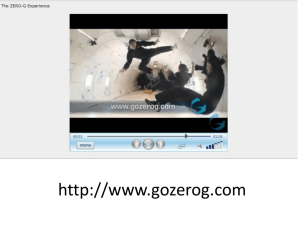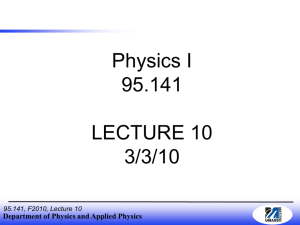5-8 Satellites and “Weightlessness”
advertisement
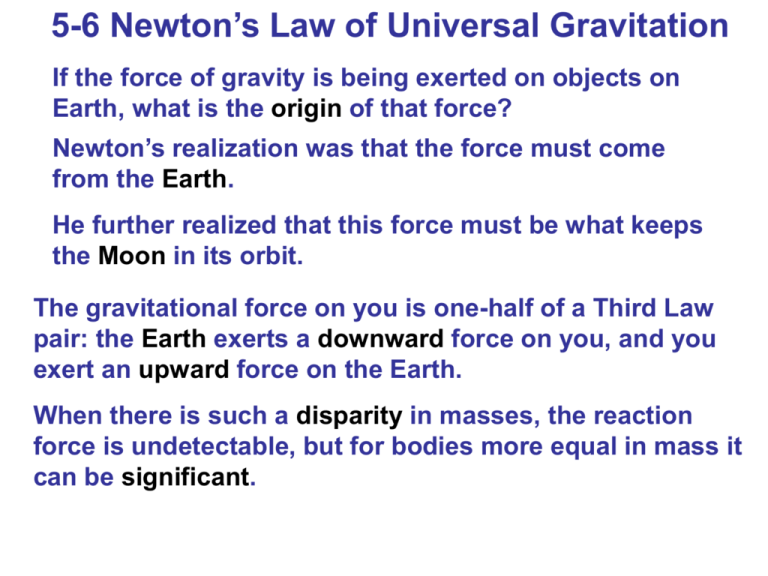
5-6 Newton’s Law of Universal Gravitation If the force of gravity is being exerted on objects on Earth, what is the origin of that force? Newton’s realization was that the force must come from the Earth. He further realized that this force must be what keeps the Moon in its orbit. The gravitational force on you is one-half of a Third Law pair: the Earth exerts a downward force on you, and you exert an upward force on the Earth. When there is such a disparity in masses, the reaction force is undetectable, but for bodies more equal in mass it can be significant. 5-6 Newton’s Law of Universal Gravitation Therefore, the gravitational force must be proportional to both masses. By observing planetary orbits, Newton also concluded that the gravitational force must decrease as the inverse of the square of the distance between the masses. In its final form, the Law of Universal Gravitation reads: (5-4) where Example 5-10 A 50 kg person and a 75 kg person are sitting on a bench. Estimate the magnitude of the gravitational force each exerts on the other. Assume the people are 0.5 m apart, and round off the value of G to 10 -10 Nm2 /kg 2 since we are just estimating. m1m2 (10 -10 Nm2 /kg 2 )(50 kg)(75 kg) -6 F =G r = = 10 N 2 r (0.5 m) Example 5-11 What is the force of gravity acting on a 2000. kg spacecraft when it orbits two Earth radii from the earth’s center (that is, a distance rE=6380 km above the earth’s surface)? The mass of the earth is ME=5.98x1024 kg. We could plug in all the numbers, or we can recognize that increasing the height by 2 results in a decrease of the gravitational force by 4. So 1 1 F = mg = (2000. kg)(9.8 m/s 2 ) = 4900 N 4 4 5-7 Gravity Near the Earth’s Surface; Geophysical Applications Now we can relate the gravitational constant to the local acceleration of gravity. We know that, on the surface of the Earth: Solving for g gives: (5-5) Now, knowing g and the radius of the Earth, the mass of the Earth can be calculated: 5-7 Gravity Near the Earth’s Surface; Geophysical Applications The acceleration due to gravity varies over the Earth’s surface due to altitude, local geology, and the shape of the Earth, which is not quite spherical. Example 5-13 Estimate the effective value of g on the top of Mt. Everest, 8850 m (29,035 ft) above sea level. That is, what is the acceleration due to gravity of objects allowed to fall freely at this altitude? mE (6.67x10 -11 Nm2 /kg 2 )(5.98x10 24 kg) 2 g =G 2 = = 9.77 m/s r (6.389x10 6 m) 2 5-8 Satellites and “Weightlessness” Satellites are routinely put into orbit around the Earth. The tangential speed must be high enough so that the satellite does not return to Earth, but not so high that it escapes Earth’s gravity altogether. 5-8 Satellites and “Weightlessness” The satellite is kept in orbit by its speed – it is continually falling, but the Earth curves from underneath it. Example 5-14 A geosynchronous satellite is one that stays above the same point on the earth, which is possible only if it is above a point on the equator. Such satellites are used for TV and radio transmission, for weather forecasting, and as communication relays. Determine (a) the height above the earth’s surface such a satellite must orbit, and (b) such a satellite’s speed. (c) Compare to the speed of a satellite orbiting 200 km above Earth’s surface. v2 Gm satmE v2 (a) F = ma, a = = msat r r2 r 2r v= , T = 1 d = (24 h)(3600 s/h) = 86,400 s T Gm E (2r) 2 Gm E T 2 (6.67x10 -11 Nm2 /kg 2 )(5.98x10 24 kg)(86, 400 s) 2 3 = r = = = 7.54x10 22 m3 2 2 2 2 r rT 4 4 r = 4.23x10 7 m Gm E (6.67x10 -11 Nm2 /kg 2 )(5.98x10 24 kg) (b) v = = = 3070 m/s r (4.23x10 7 m) (c) r' = rE + h = 6380 km + 200 km = 6580 km v' = v r 42,300 km = (3070 km/s) = 7780 km/s r' 6580 km 5-8 Satellites and “Weightlessness” Objects in orbit are said to experience weightlessness. They do have a gravitational force acting on them, though! The satellite and all its contents are in free fall, so there is no normal force. This is what leads to the experience of weightlessness. More properly, this effect is called apparent weightlessness, because the gravitational force still exists. It can be experienced on Earth as well, but only briefly (for example, jumping). 5-8 Satellites and “Weightlessness” (a) w-mg=0 (b)w-mg=ma so w=ma+mg=mg+0.5mg=1.5mg (c) w=ma+mg=-mg+mg=0 5-9 Kepler’s Laws and Newton's Synthesis Kepler’s laws describe planetary motion. 1. The orbit of each planet is an ellipse, with the Sun at one focus. 5-9 Kepler’s Laws and Newton's Synthesis 2. An imaginary line drawn from each planet to the Sun sweeps out equal areas in equal times. 5-9 Kepler’s Laws and Newton's Synthesis The ratio of the square of a planet’s orbital period is proportional to the cube of its mean distance from the Sun (see table 5-2 for planetary data). Kepler’s laws can be derived from Newton’s laws. Irregularities in planetary motion led to the discovery of Neptune, and irregularities in stellar motion have led to the discovery of many planets outside our Solar System. Example 5-15 Mars’ period (its year) was noted by Kepler to be about 687 Earth days, which is 1.88 yr. Determine the distance of Mars from the Sun using the earth as a reference. 2/3 1.88 yr 2/3 rMS TM = = = 1.52 rES TE 1 yr rMS = 1.52rES = 1.52(1.50x10 11 m) = 2.28x1011 m Example 5-16 Determine the mass of the sun given the earth’s distance from the sun as rES=1.5x1011 m. T = (1 yr)(365.25 d/yr)(24 h/d)(3600 s/h) = 3.16x10 7 s 3 4 2 (1.5x1011 m) 3 4 2rES 30 Ms = = = 2.0x10 kg 2 -11 2 2 7 2 GTE (6.67x10 Nm /kg )(3.16x10 s) 5-10 Types of Forces in Nature Modern physics now recognizes four fundamental forces: 1. Gravity 2. Electromagnetism 3. Weak nuclear force (responsible for some types of radioactive decay) 4. Strong nuclear force (binds protons and neutrons together in the nucleus) 5-10 Types of Forces in Nature So, what about friction, the normal force, tension, and so on? Except for gravity, the forces we experience every day are due to electromagnetic forces acting at the atomic level. Summary of Chapter 5 • An object moving in a circle at constant speed is in uniform circular motion. • It has a centripetal acceleration • There is a centripetal force given by •The centripetal force may be provided by friction, gravity, tension, the normal force, or others. Summary of Chapter 5 • Newton’s law of universal gravitation: •Satellites are able to stay in Earth orbit because of their large tangential speed. Homework - Ch. 5 • Questions #’s 1, 5, 8, 9, 12, 14, 16, 20, 21 • Problems #’s 5, 7, 9, 13, 17, 31, 33, 35, 37, 45, 49, 53, 57, 61

